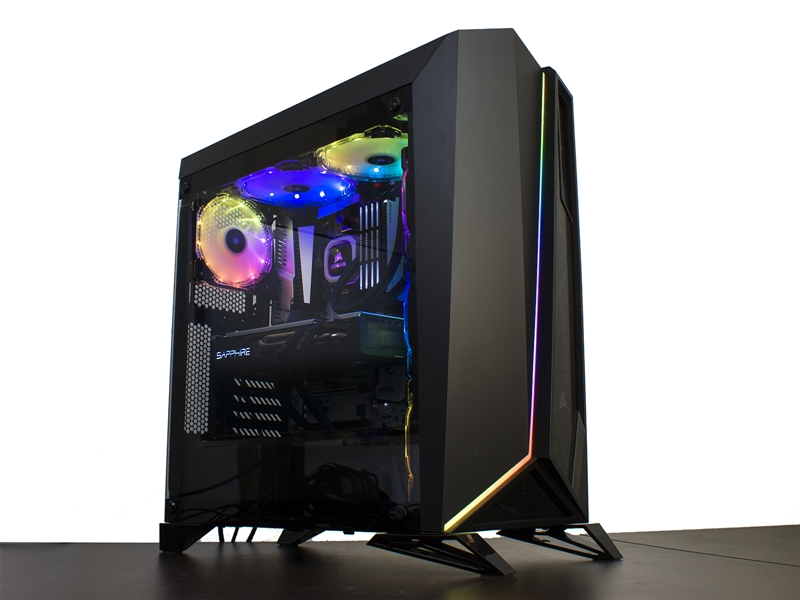Corsair Carbide Spec-Omega Mid-Tower Case Review — Page 2 of 5
Corsair Carbide Spec-Omega Exterior Overview
Corsair Carbide Spec-Omega – White Overview
Overall, the Spec-Omega is a nice looking case with it’s unique design. The unique shape of the front panel is not the only uniquely designed features on the Spec-Omega. The legs and top panel also implement the angular design to give them a different look as well. We quickly see why Corsair included a hex wrench with the Spec-Omega and the reason it was the first time you see when you open the case. The Tempered Glass side panel is held in place with hex screws rather than thumbscrews. This will be a matter of preference, however I personally prefer to use thumbscrews on the side panel as I tend to open my cases frequently.
Corsair Carbide Spec-Omega – Front I/O
The front I/O cluster is actually on the front panel, which for me is one of the best places for it. The front I/O cluster includes all standard features, a power button, dual USB 3. 1 Gen 1 ports, headphone, microphone, hard drive activity indicator and a reset button; no big surprises.
Corsair Carbide Spec-Omega – Bottom of Front Panel
The front panel is made up of two sections, in our review model the white side is solid, while the black side has a solid clear acrylic panel. Airflow into the front intake fans is provided by a little vented section at the bottom of the case. Other than this little area, the front panel is solid from top to bottom.
Corsair Carbide Spec-Omega – Top Panel
The top panel is design is similar to the front panel, where half of it is solid white, while the other half is black. One big difference here is the black portion is all vented.
Corsair Carbide Spec-Omega – Tempered Glass Side Panel
Taking a look at the Tempered Glass side panel, the first time we notice are the hex screws holding it in place rather than the thumbscrews we are used to seeing from Corsair. Next we can see that the side panel is lightly smoked, but not enough that it would obscure showing off your components. The Tempered Glass side panel also rests on the bottom feet, which makes it easier to install onto the support pegs, which have a rubber gasket to keep the Tempered Glass from chipping on the metal support posts and to reduce vibration. The unique “angular” design of the front and top panel is easily noticed when looking at the case from the side.
The Tempered Glass side panel also rests on the bottom feet, which makes it easier to install onto the support pegs, which have a rubber gasket to keep the Tempered Glass from chipping on the metal support posts and to reduce vibration. The unique “angular” design of the front and top panel is easily noticed when looking at the case from the side.
Corsair Carbide Spec-Omega – Back Panel
On the back of the case, we can see that the top panel is held in place with two thumbscrews. Other than that, everything else is exactly as we’d expect. The rear exhaust fan, motherboard port key slot, and seven expansion slots. The expansion slot covers are vented to help with airflow, while the space above the expansion slots is also vented. At the bottom of the case is the bottom mounted power supply hole. None of this should be any surprise.
Corsair Carbide Spec-Omega – Power Supply Filter Removal
With a bottom mounted power supply, it’s going to take in a lot of dust. As is common practice, Corsair has installed an easily removed dust filter on the bottom of the case.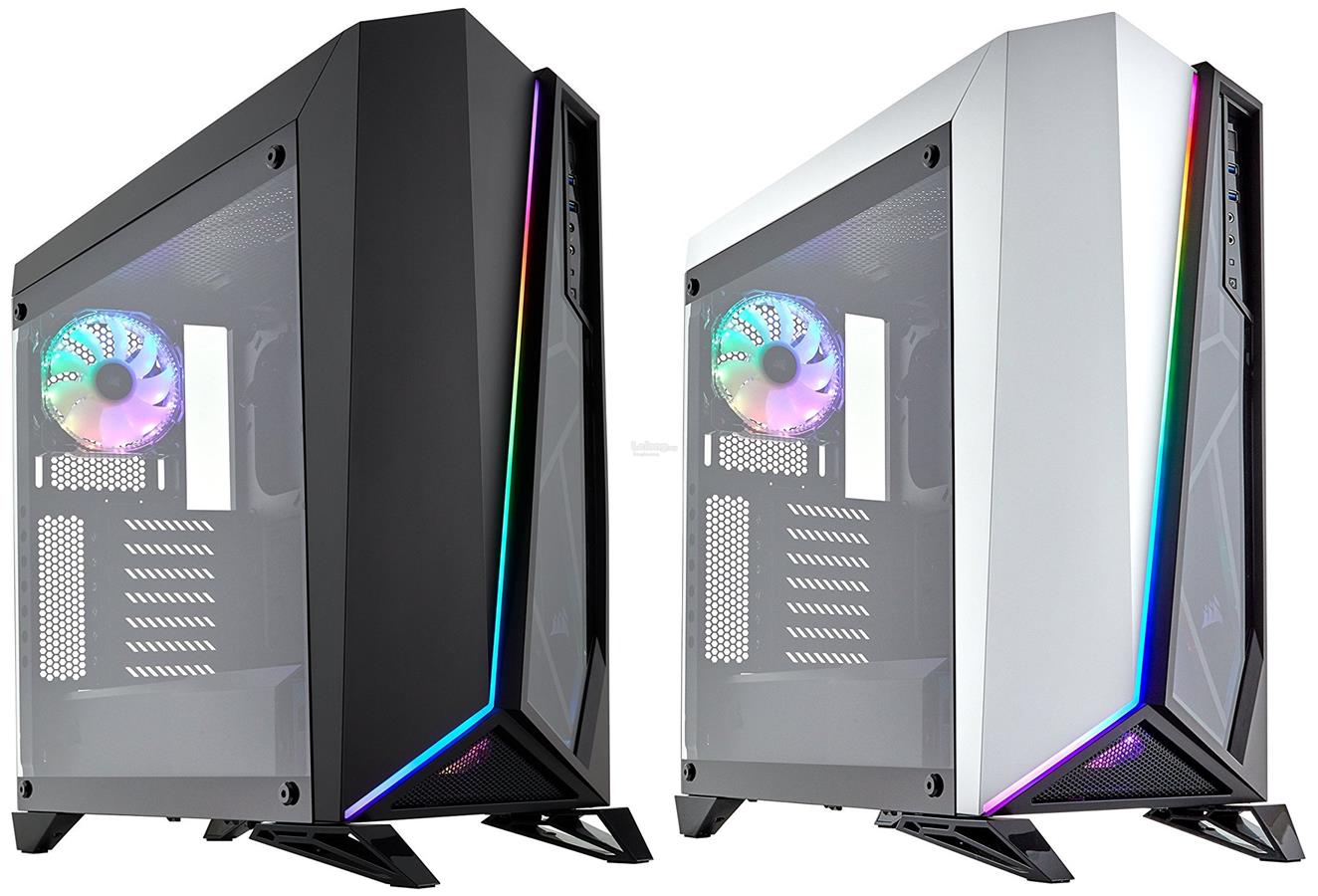 It is held in place very securely with a little slide clip. Pressing down on the filter handle and pulling it out, the filter removes from the case without any trouble.
It is held in place very securely with a little slide clip. Pressing down on the filter handle and pulling it out, the filter removes from the case without any trouble.
Corsair Carbide Spec-Omega – Bottom Panel
Taking a quick look at the bottom of the case, we find the power supply filter that we just discussed. The other features that we see is a thumbscrew, that is one of three that hold the 3.5 inch drive cage in place. The four feet each have little rubber pads, which helps reduce vibration and keep it from sliding around. There are also four slide lock slots on the bottom panel, which do not correlate to anything inside the case, so I have no idea why they are there.
Time to take off the Tempered Glass side panel and take a look at the interior.
Questions or comments?
View this thread in our forums!
Corsair Carbide SPEC-OMEGA Mid-Tower Gaming Case Review
PAGE INDEX
1. Corsair Carbide Spec-Omega Case Review2.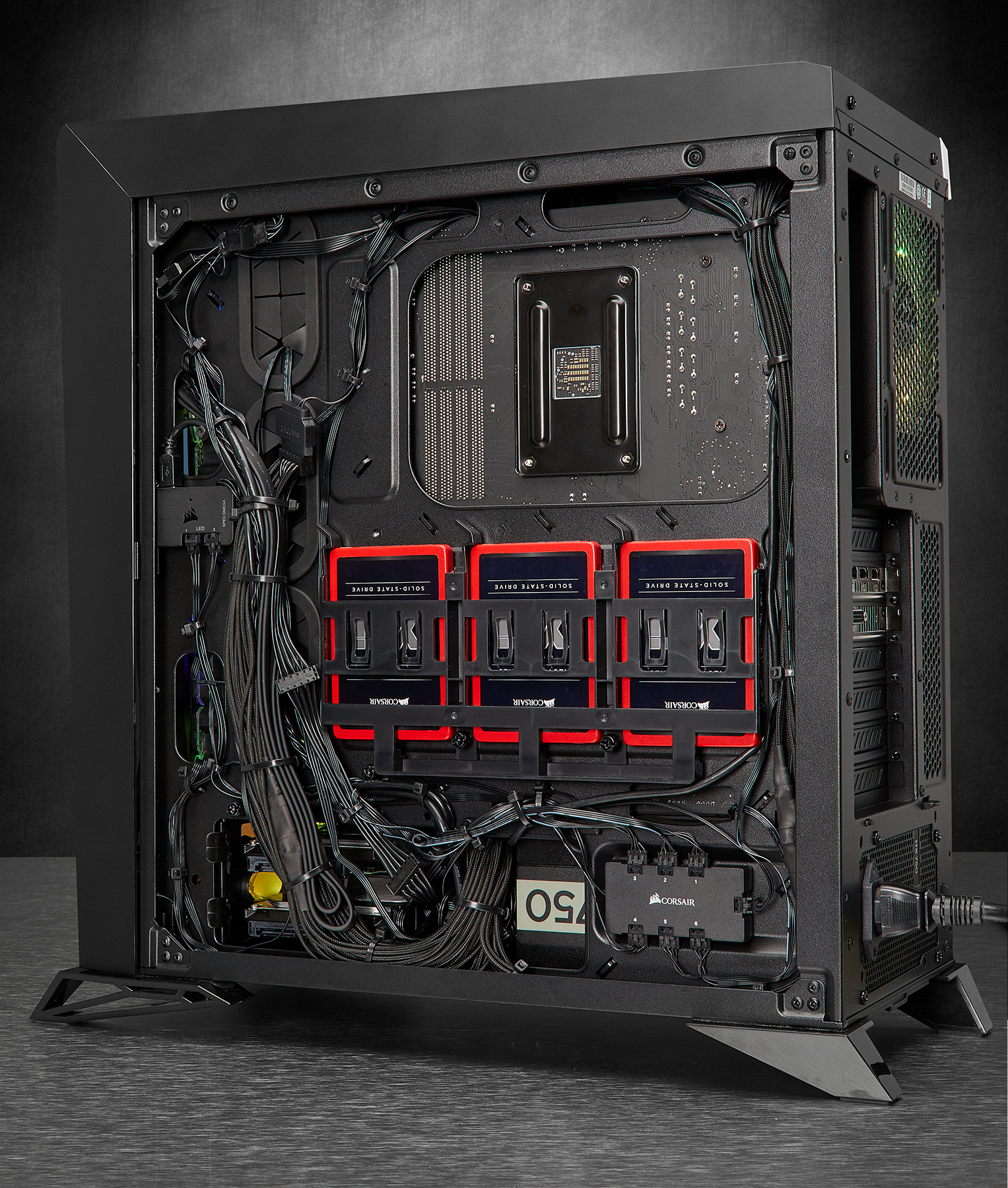 Corsair Spec-Omega Overview3. Corsair Spec-Omega Detailed Features4. Corsair Spec-Omega System Build5. Final Thoughts & Conclusion NEXT >>
Corsair Spec-Omega Overview3. Corsair Spec-Omega Detailed Features4. Corsair Spec-Omega System Build5. Final Thoughts & Conclusion NEXT >>
The Corsair Spec-Omega is a nice case. But it’s a bit annoying at the same time. While it is classified as a mid-tower case, the internal area feels more cramped than a typical mid-tower. With the removal of space normally taken to accommodate optical drives, this has made the chassis shorter in length to other mid-tower designs I have worked with before.
Ironically, the SilverStone PS11 series is pretty close in dimensions, but makes much better use of the case enclosure. That case can fit two 5.25in optical drives, while the Spec-Omega doesn’t support any. This is an obvious trade-off in design to facilitate large radiator support, while the PS11 case has very limited radiator support.
Quite a bit of the length on the case is due to the huge plastic front panel. There is a large cavity in between the chassis and panel, so you can mount fans in a push, pull, or push-pull configuration. But I feel that Corsair might of taken a bit too much of the internal space away for this configuration.
But I feel that Corsair might of taken a bit too much of the internal space away for this configuration.
The components I’m using in this build are pretty typical in size for a gaming rig. It all just feels a bit too cramped. Granted if you were to plan hardware around this case, and weren’t using components already on hand, as I did, buying smaller components is the way to go with the Spec-Omega, if you do not like the cramped feel.
I have pretty mixed feelings about this case, if it wasn’t obvious by now. On one hand I like the sleek design to break up the monotonous rectangle box syndrome that you have with a lot of cases on the market.
Yet some of those design choices hurt performance of the case as well. Choosing to put glass in the front panel instead of a grill causes air flow to enter from the bottom and the top of the case. This definitely causes reduced efficiency with the fans mounted on the front of the case. How much so, that’s debatable, and I do not own the equipment to test such variables.
How much so, that’s debatable, and I do not own the equipment to test such variables.
There could be a possible solution to this problem, considering the front panel looks to be high-jacked from the Spec-Alpha series of cases. The part that has the glass in it, looks to be the same exact part on the Spec-Alpha, only they have a mesh grill installed instead. I think Corsair should have this as an optional part, either included with the case when it ships, or as an accessory you can buy if cooling becomes a serious issue.
Performance is mixed. The Spec-Omega works as Corsair says it would. It did indeed fit a 360mm radiator, and 180mm PSU (just barely). But, with the front panel designed the way it is, it offers little air for the radiator fans up front. I know how this radiator performs because I have been using it for a couple of months now and the coolant temps are definitely higher in the Spec-Omega due to this design choice.
Appearance is always subjective, but I really like the look of this case. The black and white aesthetic is done well, and the angular bits of the panels on the front and top of the case in combination with it’s unique feet design gives enough angles to keep you from realizing underneath it all is a rectangular box.
The black and white aesthetic is done well, and the angular bits of the panels on the front and top of the case in combination with it’s unique feet design gives enough angles to keep you from realizing underneath it all is a rectangular box.
Construction is pretty solid, with a couple of caveats. One issue I have is with the front panel. It is a pain to get off without feeling like you are going to break one of the plastic tabs. The wire connecting at the bottom for the LED also adds to this annoyance.
The other issue I had with my sample was the bottom rear tempered glass mounting screw goes in slightly crooked. I’m not sure if this was bent during manufacturing or when the screw was mounted to hold the glass in place. The case comes in the box with the glass panel mounted, and I highly doubt it was caused by shipping, as the box the case arrived in was intact and had no holes or crumbled corners.
Functionality of the Spec-Omega is another mixed result for me.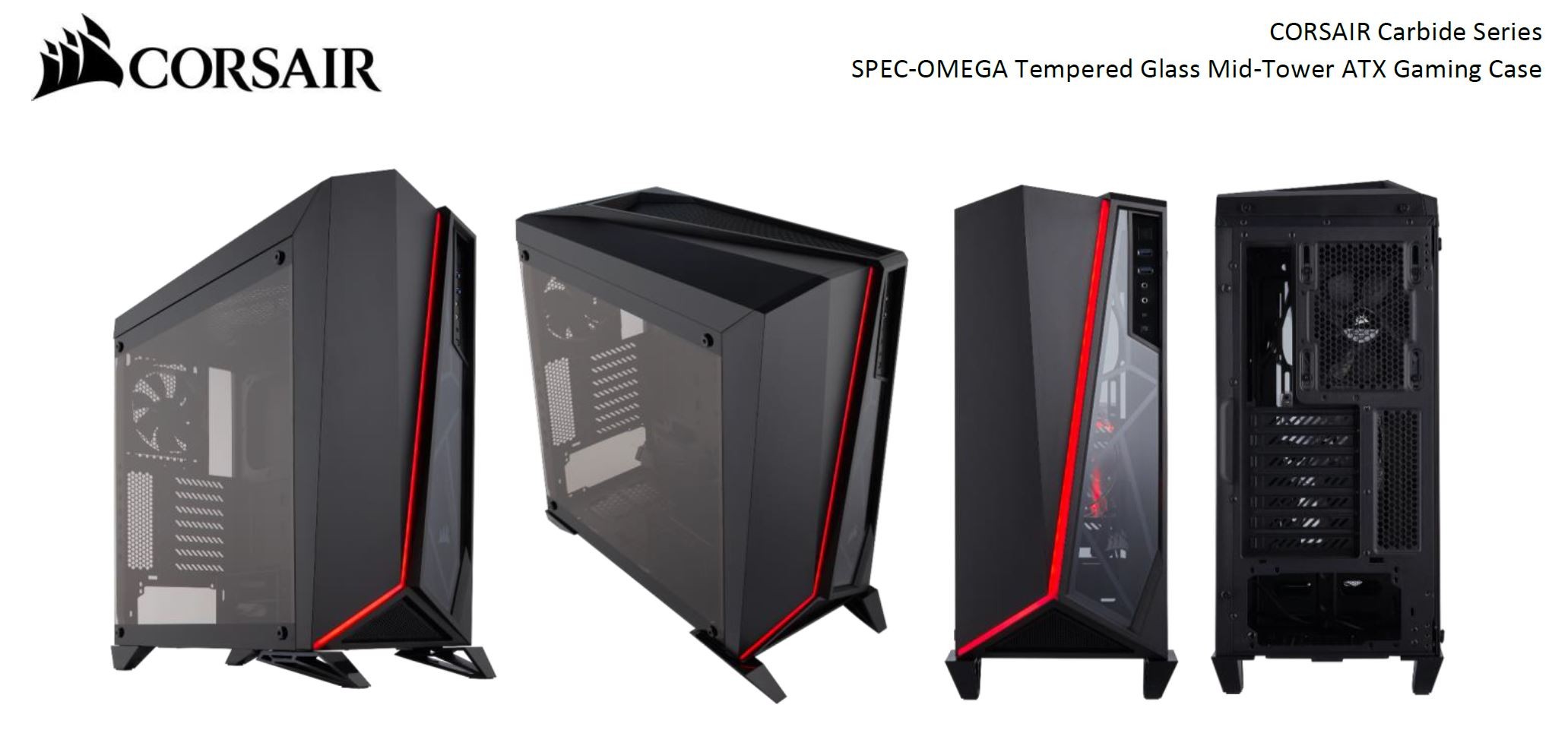 As this kind of ties in with performance, it’s the issues with airflow and cramped space. The airflow being the one key functionality of the case that was sacrificed for design aesthetics. This shouldn’t happen with case designs, but we are seeing it more and more lately.
As this kind of ties in with performance, it’s the issues with airflow and cramped space. The airflow being the one key functionality of the case that was sacrificed for design aesthetics. This shouldn’t happen with case designs, but we are seeing it more and more lately.
Value at the time of writing this article is hard to judge. At the pre-release time of this writing, I only have the MSRP of $99.00 to go by. The case could retail for less, but I have to go by what price I have in front of me right now. At the current price this case is a bit on the pricey side for what it offers. There are other cases on the market (the Cooler Master MasterBox Lite 5 RGB comes to mind) that offer tempered glass in the mid-tower range with prices in the $60.00 range and up. I do not see anything significantly better with the Corsair Spec-Omega to say this case is a good value when looking at other cases with similar specs as this one.
EDITOR: Spec-Omega is available at launch (8 January 2018) for $135. 99 (Newegg | Amazon).
99 (Newegg | Amazon).
I can only recommend this case to people who really like the design and look of the Spec-Omega. As the design stands now, front cooling performance is hampered with the mostly closed off front panel. The tiny triangular opening at the bottom of the front panel and what air can be pulled from the top of the case isn’t going to cut it for airflow.
This case seems better suited to smaller components. If I was planning a whole new build around this case, I would choose components more wisely as I mentioned in the build section, especially a PSU with flat power cables instead of round ones for easier cable management. But, then again, I discovered the issues with this case while building with it. As it’s designed as a mid-tower case, I certainly expected a bit more room to build in than what was actually supplied by the Spec-Omega case.
Pros:
+ Small compact design
+ Handles 360mm radiators
+ Aesthetically pleasing design
Cons:
– Restricted front airflow
– No optical drive bays
– Limited 3. 5 HDD capacity
5 HDD capacity
– Front panel is hard to remove
Ratings:
-
Performance: 7.50
-
Appearance: 9.75
-
Construction: 8.50
-
Functionality: 7.50
-
Value: 7.75
SKIP TO PAGE:
1. Corsair Carbide Spec-Omega Case Review2. Corsair Spec-Omega Overview3. Corsair Spec-Omega Detailed Features4. Corsair Spec-Omega System Build5. Final Thoughts & Conclusion NEXT >>
Pages: 1 2 3 4 5
Case Corsair Carbide SPEC-OMEGA RGB specs overview
- All parameters
- Similar models (10)
| Basic | |
|---|---|
| Form factor: | ATX |
| Installation options: | vertical |
| Size: | Midi Tower |
| Direction: | gaming |
| Body material: | steel |
Internal 3.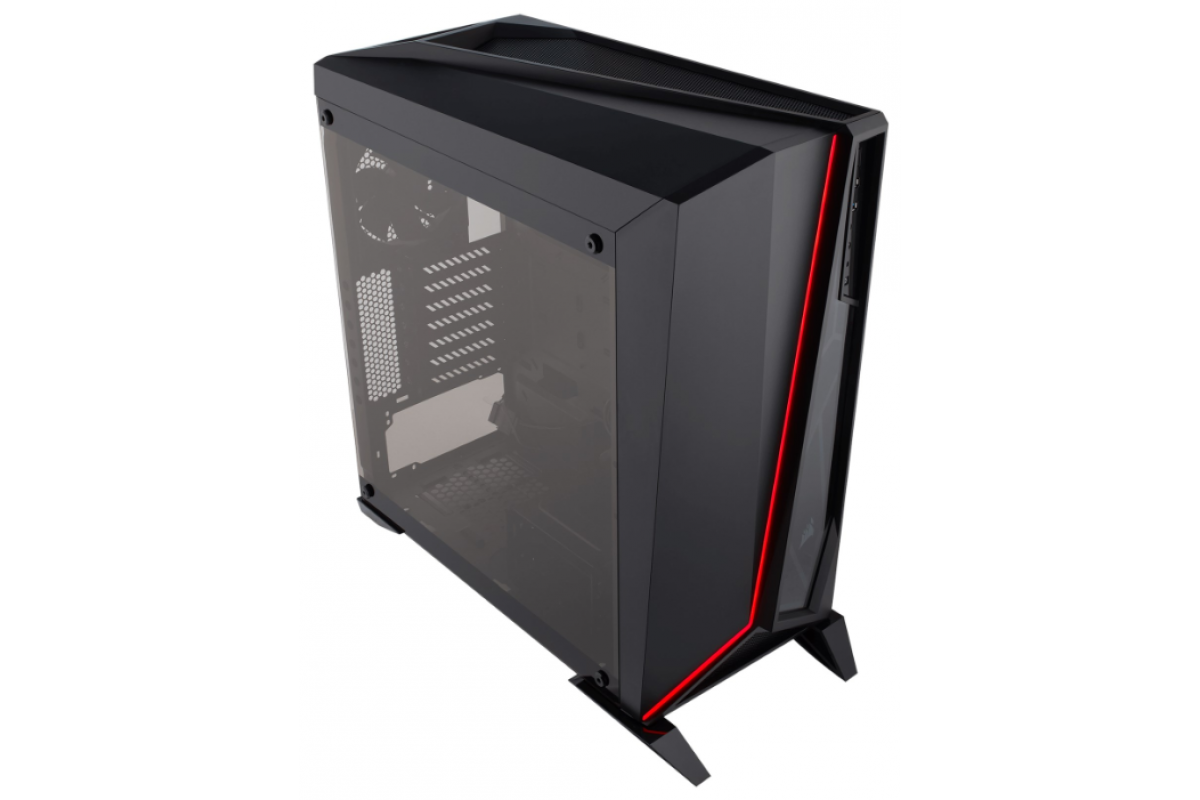 5″ bays: 5″ bays: |
3 |
| 2.5″ bays: | 2 pcs |
| Opener: | one wall removed |
| Motherboard type: | ATX |
| Case | |
| Video card length, up to: | 370 mm |
| Cooler height, up to: | 170 mm |
| Rubber feet: | |
| Interior | |
| PSU location: | lower |
| Cooling and blowing | |
| Installed fans: | 2 pcs |
| Fan slots: | 6 |
| Rear fan positions: | 1x120mm |
| Front fan positions: | 3x120mm |
| Top fan positions: | 2x120mm |
| Front grille: | |
| Dust filter: | |
| Water cooling system | |
|---|---|
| Possibility of installing CBO: | |
| Seats for CBO: | 3 |
| CBO front size: | 360mm |
| CBO top size: | 240mm |
| CBO back size: | 120mm |
| Connectors and functions | |
| Location: | on front panel |
USB 3.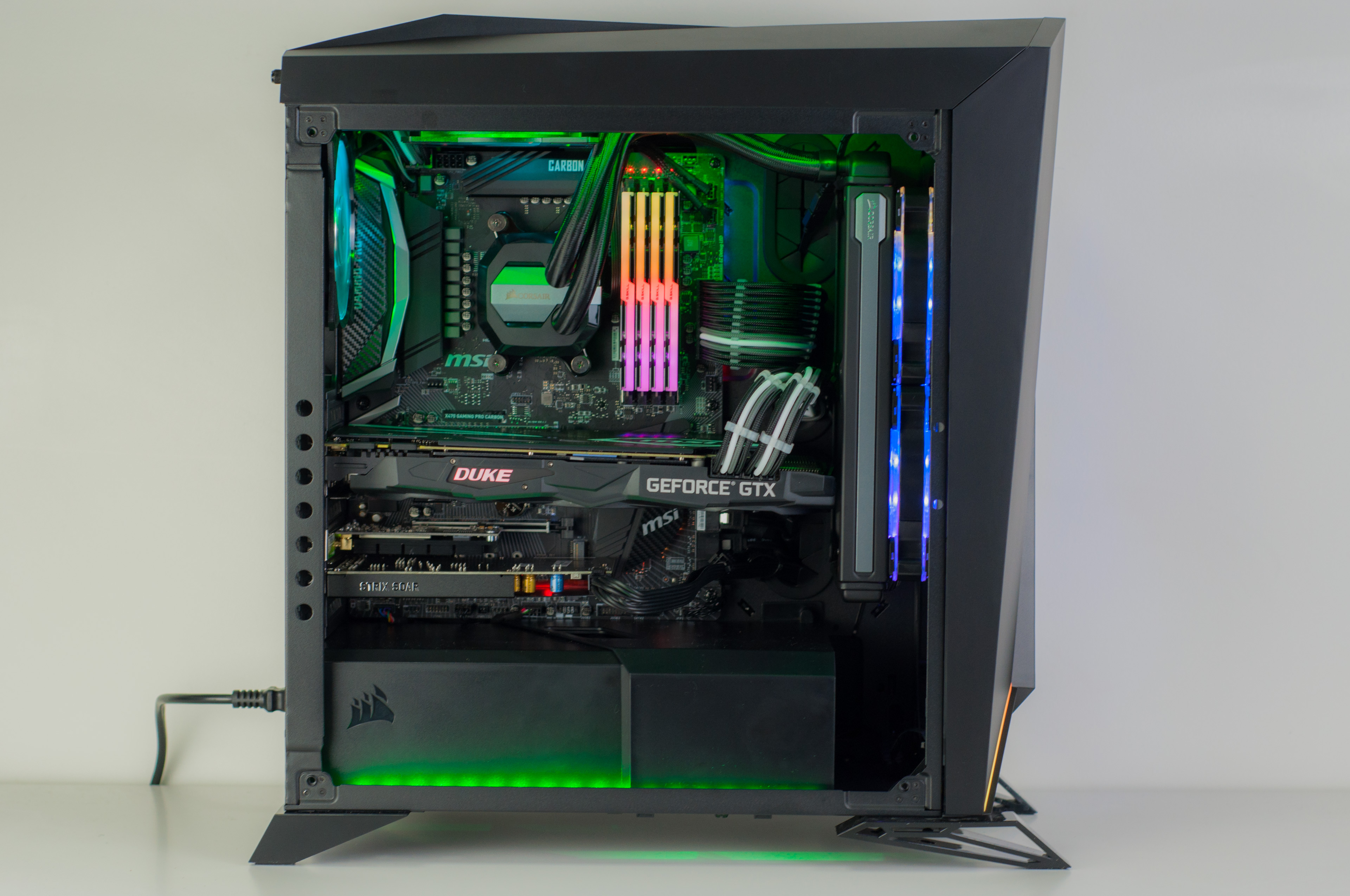 2 gen1: 2 gen1: |
2 pcs |
| Audio (mic/headphone): | |
| Optional | |
| Backlight timing: | Corsair iCUE |
| Backlight type: | illuminated fan / housing |
| Illumination color: | RGB |
| Body colour: | black |
| Dimensions: | 516x232x495 mm |
| Weight: | 7.75 kg |
| Optional: | sidebar window; hidden wiring; CO installation window for the processor; |
Dear visitors, the description of the characteristics of the «Corsair Carbide SPEC-OMEGA RGB Case» is taken from open sources or from the manufacturer’s website. If you notice an error, please report it.
Case Corsair Carbide Spec-Omega RGB Black (CC-
40-WW) without PSU — credit, payment in parts in WO.ua
Brief characteristics Corsair Carbide Spec-Omega RGB Black (CC-
40-WW) without PSU
| Case type | Miditower | |
| Motherboard form factor | ATX, Mini-ITX, microATX |
All specifications
Out of stock
Other products by brand Corsair
Compare 9 models0144
Corsair iCUE 5000X RGB Tempered Glass White (CC-
Case Corsair 4000D AIRFLOW Tempered Glass White (CC-
Corsair iCUE 5000X RGB QL Tempered Glass White without PSU (CC-
Case Corsair Carbide 275R TempeRed Glass Black (CC-
32-WW) w/o PSU
Case Corsair Carbide 275R TempeRed Glass White (CC-
33-WW) without PSU
The Carbide Series Spec-Omega RGB is a mid-tower PC case featuring a striking geometric design and a unique tempered glass side panel. A tempered glass front panel window and programmable RGB backlight profiles make this Spec case one of a kind.
A tempered glass front panel window and programmable RGB backlight profiles make this Spec case one of a kind.
Spec’s distinctive body with unmistakable style
Asymmetrical geometric design and integrated RGB LED strip give the Spec-Omega RGB a bold, unique and modern look.
Use the built-in lighting profiles or create your own
The included Digital RGB Lighting Node PRO controller lets you easily select new lighting modes from a wide range of built-in effects or create your own using iCUE software.
Extensive cooling options
Space for six 120mm radiators or a Hydro Series radiator up to 360mm at the front, 240mm at the top and 120mm at the rear.
Tempered Aesthetics
Featuring a tempered glass front and side panel, you can display your system while the included power supply shroud hides cables and drives to keep the interior clean.
Lots of RGB LEDs
30 front panel RGB LEDs and two included Corsair HD120 RGB fans provide full RGB customization.